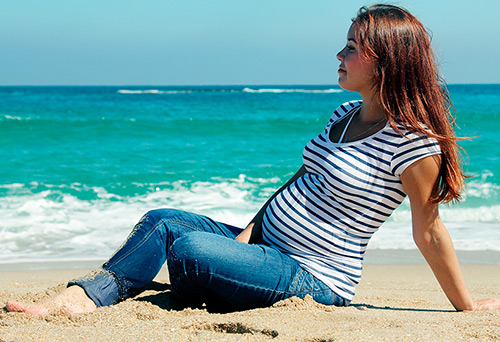Cosmetics and makeup
How to sunbathe in the sun
With the onset of summer, every girl wants to look great - the beach season is announced open! However, in recent years, scientists have been talking about intense solar activity and are forcing us to be more careful about sunbathing in the sun. But this does not mean at all that you need to give up wonderful sunbathing - the main thing is to do it right.
How to sunbathe in the sun this summer?
To begin with, all people tan differently. Some girls look dark-skinned, not even particularly staying in the sun. Others remain quite light even in summer. It depends on the type of skin and how it perceives UV rays. Therefore, girls with fair skin need to sunbathe in the sun, be much more careful and start with very small doses of sun exposure, with the obligatory use of sunscreens. Light skin is thinner, more delicate, quickly burns, and at the same time does not tan well. For her, it is best to use products with a large number of UV filters. There are products with UV filter 10, 15, 20, 30 and 40. Therefore, girls with very fair skin should choose products with a protective factor of 30-40. If your skin is slightly tanned, the number of factors from 20 to 30 is intended for you. If you are the owner of dark, olive skin, you will only need products with 10-15 UV protection filters.
1. How to sunbathe in the sun - tanning products.
And now about the means. There are a lot of them and they are available in different forms. Exists sunscreen, milk, mousses, gels, tanning oils. In addition, pre- and post-tanning agents are also isolated. It is believed that for dry skin it is better to use a sunscreen, and for normal to oily skin it is better to use more liquid products. At the same time, products with a more liquid consistency (milk, mousse) wear off faster and require reapplication, while the cream lasts longer on the skin. If the skin is oily enough, it is recommended to use a tanning gel - it is easier to apply and does not leave an oily sheen on the skin.
All sunscreens must be applied to clean skin to ensure that the tan is evenly distributed. For a smoother tan, a few days before visiting the beach, you can use mild body scrubs. After taking solar treatments, it is recommended to rinse the body with warm water, and then apply an after-sun product - it can be nourishing milk, lotion or special oil. As a rule, tanning oils have a low content of UV filters, and therefore, they can be successfully used as after-sun products to nourish and regenerate the skin. In this regard, such a thing as thermal water can also come in handy. It will refresh and soothe the skin after sun treatments, as well as create the necessary hydration.
2. How to sunbathe in the sun - the rules!
And now - the general rules for safe tanning and sun exposure. First of all, you need to control time. Experts advise to start sun procedures with 5 minutes of exposure to the open sun, and then gradually bring it up to more, but no more than 60 minutes. People with very light skin can start tanning in a light, diffused partial shade.
It is best to cover your hair and head with a light headgear. It will protect them from drying out, and your head from sunstroke. When sunbathing, do not lie in one position all the time - try to change your position about every 10 minutes.
It is best to gradually increase your tanning time by 5-10 minutes each day. It is also recommended to apply sunscreen several times to the most vulnerable areas for burns - the shoulders, nose and chest.The skin on your shoulders can burn so quickly that you won't even notice. (This happened to me recently, although there was no purpose to sunbathe at all, we just relaxed in nature. We spent time under a canopy and at a table, made only short trips to the water under the scorching sun. burn out!)
The best time to sunbathe is until 11 am and from 4 pm. In the hottest period - from 12 to 14, being in the sun is strongly discouraged.
Sunscreen is best applied in a thin layer half an hour before tanning. During this time, they will have time to be absorbed into the skin and begin their protective effect.
It is not recommended to use self-tanning cream when visiting the beach. It contains pigment particles that interfere with normal skin breathing and natural tanning.
Proper nutrition also matters. Eating foods with a high beta-carotene content (for example, carrot juice or apricots) promotes the production of melanin pigments in the skin and enhances the tanning effect.
Guided by these simple rules, you can get an even, beautiful tan without harming your health and skin. After all, our skin needs a careful attitude and all mistakes and neglect in youth will affect the premature appearance of wrinkles in adulthood.
Comments and Reviews
Add a comment
Rating news
Shades of clothing that make women look younger
What shades of hair make women younger: rules and photos
Funny wedding dresses - photos and ideas
12 most expensive down jackets for the winter
How to look 25 at 40: tips from supermodels
Beautiful schoolgirls
Anti-aging haircuts and hairstyles for women
Fashionable skirts for autumn and winter
Fashionable women's trousers for the cold season
Fashionable and stylish sandals for summer 2024
Spring-summer 2024
 Fashionable dresses and tops with thin spaghetti straps
Fashionable dresses and tops with thin spaghetti straps
 Bandana tops: how to wear stylishly and beautifully
Bandana tops: how to wear stylishly and beautifully
 How to put together the perfect men's wardrobe for the summer
How to put together the perfect men's wardrobe for the summer
 Fashionable shorts for spring-summer 2024
Fashionable shorts for spring-summer 2024
 Fashionable skirts for spring-summer 2024: a guide to online shopping
Fashionable skirts for spring-summer 2024: a guide to online shopping
 The most fashionable dresses spring-summer 2024: styles and colors
The most fashionable dresses spring-summer 2024: styles and colors
 Fashionable total look 2024: image ideas and trends
Fashionable total look 2024: image ideas and trends







